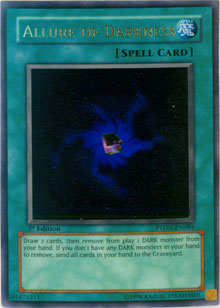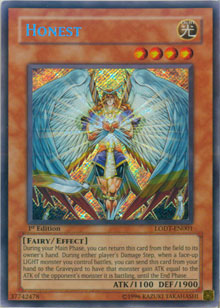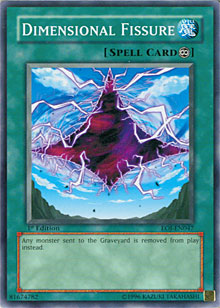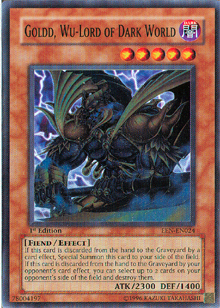Gorz is huge, free, and goes in everything even if it fits like a square peg in a round hole. Check it out:
Gorz the Emissary of Darkness
Fiend / Dark
Level 7 / Effect
2700 ATK / 2500 ATK
When you take damage from a card your opponent controls while you control no cards, you can Special Summon this card from your hand. Then activate the appropriate effect, based on the type of damage.
-Battle Damage: Special Summon 1 "Emissary of Darkness Token" (Fairy-Type / Light / Level 7 / ATK? / DEF?) Its ATK and DEF are each equal to the amount of battle damage you took.
-Effect Damage: Inflict damage to your opponent equal to the amount of damage you took.
It doesn’t even matter what you play: just cram it in there and let it win you games!
That’s it for this one. See you next week!
—Jason Grabher-Meyer
Just kidding! A lot of people would have you believe that Gorz, Emissary of Darkness really is that simple: that it’s just a broken card that goes in anything and instantly wins you the game when it hits the field. Now, I’m not saying they’re completely wrong—Gorz is one of the best cards ever printed, and it’s incredibly splashable. This thing is a dangerous, game-shaping force of nature. You can have no idea what you’re doing and still steal wins with it. But a skilled player who understands the cerebral impact this card can have—as well as its potential in a variety of different matchups—is going to get a lot more out of it than someone who blindly flops it when the opportunity to do so just happens to stroll past.
Gorz is going to have a significant impact on the game: whenever your opponent is left with an empty field, you’re going to have to wonder whether or not they’re holding Gorz, and if so, how to deal with it. Even if your opponent has a single set spell or trap card, you’re going to have thoughts like, "Is that Dust Tornado? If I attack, will he chain it and then drop Gorz?" Chainable cards like Enemy Controller and Raigeki Break (cards that can extricate Gorz from the field during the battle phase) will gain a leg up over cards like Book of Moon and Phoenix Wing Wind Blast. Utility-challenged decks suffering from weak openings will have the option of simply passing with nothing out, threatening a free, massive beatstick and a tokenized battle buddy should the opponent attack.
Let’s look at the bigger impacts this card will have, where it’ll make those impacts, and who wins as a result.
OTKs Lose, Slow Decks Win
 When Dark Armed Dragon Return rose to power last March, it defined itself as the most dominant, frustratingly powerful OTK deck since the days of Cyber-Stein. For most, it was a game-ruining archetype that sucked the fun out of competitive dueling. The weird part was that such a deck never rose to power in Japan, so the March 1 Advanced List didn’t do much to preempt the deck’s potential. How did Japanese players dodge the OTK bullet?
When Dark Armed Dragon Return rose to power last March, it defined itself as the most dominant, frustratingly powerful OTK deck since the days of Cyber-Stein. For most, it was a game-ruining archetype that sucked the fun out of competitive dueling. The weird part was that such a deck never rose to power in Japan, so the March 1 Advanced List didn’t do much to preempt the deck’s potential. How did Japanese players dodge the OTK bullet?
There were several answers: Allure of Darkness was a TCG exclusive at the time and contributed a bit to the deck’s reliability. But a bigger issue was the availability of answers to field-sweeping OTK turns: Japan had one, and we didn’t. That answer was Gorz.
The most common win condition for Dark Armed Return was to summon Dark Armed, remove Dark monsters from the graveyard to pay for its field-clearing effect, and follow it up with Return from the Different Dimension or Dimension Fusion to bring the removed monsters back. The result was usually two 2800 ATK monsters (Dark Armed Dragon and either Dark Magician of Chaos or Darklord Zerato), backed by smaller monsters like Armageddon Knight, Dark Grepher, or Destiny Hero - Dasher. The result was a combined ATK of anywhere between 8000 and 10000 points.
Those are important numbers if we stick Gorz into the mix: even if the opponent makes ideal attacks starting with the smallest attacker and working his or her way up (to minimize the size of the token Gorz summons), the Gorz player can summon Gorz off the third of five attacks. Even if that third attacker is something small like Elemental Hero Stratos, Gorz hits the field in defense mode and brings a token monster along for the ride—and that token comes out in defense position too. At that point the remaining copies of Dark Armed Dragon, Dark Magician of Chaos, or Zerato can’t deal any damage: the Gorz player loses life points to just three of the five attacking monsters, and the OTK is disrupted.
The same scenario applies today, with Teleport Dark Armed Dragon taking the place of Dark Armed Return. TeleDAD is an amazing deck with an incredible toolbox of effects, but when it comes to sheer damage output it doesn’t usually match Dark Armed Return. Most of its kill turns revolve around two Synchro monsters and three smaller monsters, and even if you sub out one of the weaker monsters for Dark Armed Dragon, the Gorz-wielder can still block your two biggest hits and survive to battle back next turn. At that point the TeleDAD duelist has played him- or herself out and committed to the field, leaving that player vulnerable and over-extended.
The Beauty of the Situation . . .
. . . is that while Gorz shuts down OTK decks, it doesn’t do a whole heck of a lot against more restrained strategies. Decks that play to a less explosive pacing still feel Gorz’s wrath, but it doesn’t hurt as much because these decks don’t over-extend so readily. Once Gorz is summoned they can get rid of it, and losing one battle phase isn’t so big of a blow.
 Gladiators can eliminate Gorz with Gladiator Beast Murmillo or Gladiator Beast Gyzarus. They can even negate its Token-summoning effect and destroy it with Gladiator Beast War Chariot. Lightsworn can eliminate it with Celestia, Lightsworn Angel, or swing right over it with Honest. In the case of Little City, eliminating Gorz could be as easy as playing Skyscraper, and Skill Drain will keep Gorz from summoning its token. Counter Fairies can deal with both threats: chaining Divine Wrath to Gorz’s token summoning effect will prevent the token from being summoned while also destroying Gorz.
Gladiators can eliminate Gorz with Gladiator Beast Murmillo or Gladiator Beast Gyzarus. They can even negate its Token-summoning effect and destroy it with Gladiator Beast War Chariot. Lightsworn can eliminate it with Celestia, Lightsworn Angel, or swing right over it with Honest. In the case of Little City, eliminating Gorz could be as easy as playing Skyscraper, and Skill Drain will keep Gorz from summoning its token. Counter Fairies can deal with both threats: chaining Divine Wrath to Gorz’s token summoning effect will prevent the token from being summoned while also destroying Gorz.
Sure, there are going to be times where slower decks can’t overcome a random Gorz play, but that doesn’t really change the fact that over a measured span of time, Gorz is going to devastate TeleDAD much more completely than the decks fighting to keep up with TeleDAD. It may keep the speedy Zombie deck in check as well, though that’s going to be a tougher task: if the Zombie player can draw his or her entire deck before swinging into Gorz, it’s quite likely that player will have the ability to end the battle phase, take Gorz or its token with Creature Swap, pass, and try again on the following turn. That match is a tossup, but Gorz certainly won’t be bad there, even in a worst-case scenario.
There was a time when Gorz was hailed as a card that was flat-out bad for the game: a staple in everything, its ease of use brought nothing but chaos to games that might otherwise come down to skill. But those were different times, and today Gorz might actually prove to be a constructive presence that gives slower decks a fighting chance in ¸ber-fast metagames. It’s bizarre to think of a card with this power level as a balancing force, but that’s probably what it’s going to end up as.
Where Not to Play It
Gorz is playable in so many decks that it’s actually easier to discuss where you might not want to play it instead of where you should. Frankly, I can only come up with two reasons to not play this card: the first is that you never plan to be attacked. I guess sometime in the future there may be some sort of viable deck that runs a lockdown engine, and thus won’t want to run Gorz. For now, with dedicated Burn decks thoroughly wrecked by Hanewata, I don’t see this as a realistic scenario.
 The second possibility is a deck that runs so many continuous cards or field spells that it simply doesn’t think it can reliably main-deck Gorz. Your field needs to be entirely clear in order to summon Gorz with its effect, so if your Little City deck has Skill Drain or Royal Oppression on the field, or your Macro Cosmos deck has Dimensional Fissure or its namesake on the table, Gorz will be a dead card.
The second possibility is a deck that runs so many continuous cards or field spells that it simply doesn’t think it can reliably main-deck Gorz. Your field needs to be entirely clear in order to summon Gorz with its effect, so if your Little City deck has Skill Drain or Royal Oppression on the field, or your Macro Cosmos deck has Dimensional Fissure or its namesake on the table, Gorz will be a dead card.
Granted, such a deck could still lose its on-field infrastructure to removal cards like Dark Armed Dragon, Heavy Storm, or Judgment Dragon, in which case Gorz would suddenly become a live card again. Playing Gorz in a deck like this is a gamble, and its true viability may come down to the number of cards the deck plays that can make use of Gorz when it can’t be summoned: cards like Phoenix Wing Wind Blast and Snipe Hunter that can use Gorz as discard fodder. But to be honest, looking at comparable situations like the high number of duelists who run Crush Card Virus in Lightsworn, knowing that they’ll almost never be able to activate it, I’d expect to see Gorz in the vast majority of these decks anyway.
At That Point the Issue Becomes One of Technique
And as simple as Gorz looks, there are actually a multitude of ways to play it. The most obvious one is just the first technique of many: playing normally and letting Gorz bail you out of worst-case scenarios. Others are a bit more complicated.
The one we’re bound to see in high-profile feature matches is the opening turn pass. Don’t like your hand? Hey, don’t play anything: just pass and wait to see if your next draw smoothes things out. Barring Spirit Reaper, the odds are pretty good that whatever your opponent can shunt out on turn 1 won’t end the game then and there, especially if your pass is actually supported by Gorz and isn’t just a bluff meant to psych your opponent into restraining a potential over-extension. Even if your opponent does have Spirit Reaper and forces you to discard a card, Gorz alone will likely swing through the Reaper for 2400 damage—often a fair reward for giving up a single card.
A non-committal opening is often just as bad, because it’s far more difficult to read. Your opponent might set something that’s relatively easy to activate, such as Phoenix Wing Wind Blast or a single Bottomless Trap Hole. If you attempt to attack, your opponent will spring the trap to neutralize you. At that point if you over-extend to special summon another attacker and take advantage of the momentary opening, Gorz will hit the field and punish you on the following turn. The same scenario can play out if you set a spell or trap card and lose it to Mystical Space Typhoon. I got nailed by that myself on a trip to Tokyo back in April: on my first night out in Akihabara I hadn’t really acclimated myself to the Japanese play environment, and a duelist who was unknown to me at the time took full advantage of my forgetting about Gorz. Half a year later, Kazuki Mutsuoka’s name is one that I’m a little more familiar with.
Similar plays work well in topdecking situations as well: they offer another prime opportunity to leave an inconspicuously bare field for your opponent to attack into. Granted, when Gorz drops early on you’ve got a decent chance of having something to combat it. When it’s summoned in the late game though, answers are usually few and far between, and barring another topdecked Gorz of your own, there’s not much you can pull out to battle your opponent’s special summoned copy.
 Frankly, my favorite way I’ve seen Gorz played is a combination of the insurance plan and the late game set-up. While Dark World hasn’t been a competitive pick for quite a while, Gorz used to see play in Japanese builds of the once-popular archetype. The Dark World player could make an early push with multiple Dark World summons, and if things went wrong and those monsters were destroyed, the Dark World duelist could threaten a comeback with Gorz. It’s the perfect example of how simple strategy can elevate Gorz from a random power card into something far more dangerous, and while that particular use for the card isn’t relevant right now (not even Gorz could get me to play Dark World), it’s representative of how one can "make one’s own luck" when using this card.
Frankly, my favorite way I’ve seen Gorz played is a combination of the insurance plan and the late game set-up. While Dark World hasn’t been a competitive pick for quite a while, Gorz used to see play in Japanese builds of the once-popular archetype. The Dark World player could make an early push with multiple Dark World summons, and if things went wrong and those monsters were destroyed, the Dark World duelist could threaten a comeback with Gorz. It’s the perfect example of how simple strategy can elevate Gorz from a random power card into something far more dangerous, and while that particular use for the card isn’t relevant right now (not even Gorz could get me to play Dark World), it’s representative of how one can "make one’s own luck" when using this card.
Oh, and it beats up on people who play Solemn Judgment early as well. When you’ve only got 4000 life points, Gorz and a massive token are not the guys you want staring across the field at you.
Depending on where you play it, you’ll find your own range of techniques to make the most of this powerful new card. The catch is that you have to be alert to see all the opportunities, and you’ll do better if you can put yourself in your opponent’s shoes. Gorz is one of the most viciously threatening cards ever created, and it’s arriving at a particularly interesting time in the game’s history. It’s exactly what slower decks need to stay in the game, and it’s going to add a whole new dimension to virtually any matchup.
—Jason Grabher-Meyer